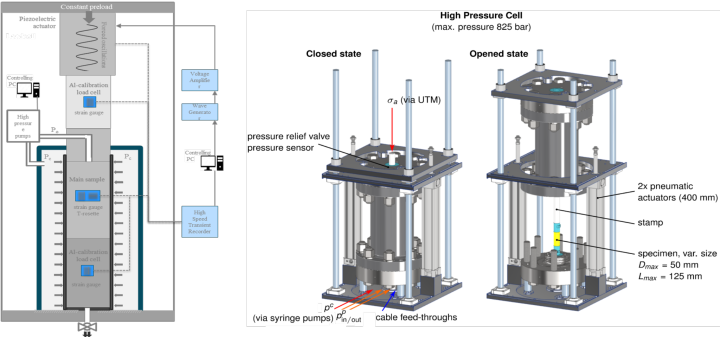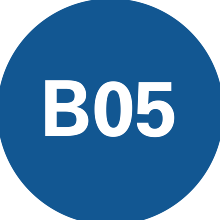People
Research Project B05 plans to cooperate closely on image-based characterisation and physical investigation of fractured rock with the group of Jens Birkholzer and Seiji Nakagawa at Lawrence Berkeley National Laboratory (LBNL, Berkeley).
A lively exchange of principal investigators and doctoral researchers between Berkeley and Stuttgart has existed for many years, especially in the field of fractured porous media systems. Recently LBNL has built an advanced laboratory for investigating the physics of hydraulic fracturing.
Publications
Journal Articles
- Fauser, D., Agudo, J. A. R., Madadi, H., Haeberle, J., Renner, J., & Steeb, H. (2025). Complex Poisson’s ratio for viscoelastic materials: direct and indirect measurement methods and their correlation. Proceedings of the Royal Society A, 481. https://doi.org/10.1098/rspa.2024.0543
- Krach, D., Ruf, M., & Steeb, H. (2025). POREMAPS: A finite difference based Porous Media Anisotropic Permeability Solver for Stokes flow. InterPore Journal, 2, Article 1. https://doi.org/10.69631/ipj.v2i1nr39
- Shokri, J., Ruf, M., Lee, D., Mohammadrezaei, S., Steeb, H., & Niasar, V. (2024). Exploring Carbonate Rock Dissolution Dynamics and the Influence of Rock Mineralogy in CO2 Injection. Environmental Science & Technology, 58, Article 6. https://doi.org/10.1021/acs.est.3c06758
- Wachsmann, S. B., Ruf, M., Prinz, C., Oehlsen, N., Zhou, X., Dyballa, M., Arweiler, C., Leistner, P., Steeb, H., Garrecht, H., Laschat, S., & Stegbauer, L. (2024). Chitin/Chitosan Biocomposite Foams with Chitins from Different Organisms for Sound Absorption. ACS Sustainable Chemistry & Engineering, 12, 11879–11890. https://doi.org/10.1021/acssuschemeng.4c00044
- Wang, J., Sonntag, A., Lee, D., Xotta, G., Salomoni, V. A., Steeb, H., Wagner, A., & Ehlers, W. (2024). Modelling and simulation of natural hydraulic fracturing applied to experiments on natural sandstone cores. Acta Geotechnica, 19, 7709–7725. https://doi.org/10.1007/s11440-024-02351-7
- Lee, D., Weinhardt, F., Hommel, J., Piotrowski, J., Class, H., & Steeb, H. (2023). Machine learning assists in increasing the time resolution of X-ray computed tomography applied to mineral precipitation in porous media. Scientific Reports, 13. https://doi.org/10.1038/s41598-023-37523-0
- Ruf, M., Lee, D., & Steeb, H. (2023). A multifunctional mechanical testing stage for micro X-ray computed tomography. Review of Scientific Instruments, 94. https://doi.org/10.1063/5.0153042
- Schmidt, P., Steeb, H., & Renner, J. (2023). Diagnosing Hydro-Mechanical Effects in Subsurface Fluid Flow Through Fractures. Pure and Applied Geophysics, 180, 2841–2860. https://doi.org/10.1007/s00024-023-03304-z
- Taghizadeh, K., Ruf, M., Luding, S., & Steeb, H. (2023). X-ray 3D imaging-based microunderstanding of granular mixtures: Stiffness enhancement by adding small fractions of soft particles. Proceedings of the National Academy of Sciences of the United States of America, 120. https://doi.org/10.1073/pnas.2219999120
- Kurzeja, P., & Steeb, H. (2022). Acoustic waves in saturated porous media with gas bubbles. Philosophical Transactions of the Royal Society A, 380. https://doi.org/10.1098/rsta.2021.0370
- Lee, D., Karadimitriou, N. K., Ruf, M., & Steeb, H. (2022). Detecting micro fractures: a comprehensive comparison of conventional and machine-learning-based segmentation methods. Solid Earth, 13, 1475–1494. https://doi.org/10.5194/se-13-1475-2022
- Schmidt, P., Jaust, A., Steeb, H., & Schulte, M. (2022). Simulation of flow in deformable fractures using a quasi-Newton based partitioned coupling approach. Computational Geosciences, 26, 381–400. https://doi.org/10.1007/s10596-021-10120-8
- Erfani, H., Karadimitriou, N. K., Nissan, A., Walczak, M. S., An, S., Berkowitz, B., & Niasar, V. (2021). Process-Dependent Solute Transport in Porous Media. Transport in Porous Media, 140, 421–435. https://doi.org/10.1007/s11242-021-01655-6
- Gao, H., Tatomir, A. B., Karadimitriou, N. K., Steeb, H., & Sauter, M. (2021). Effects of surface roughness on the kinetic interface-sensitive tracer transport during drainage processes. Advances in Water Resources, 157. https://doi.org/10.1016/j.advwatres.2021.104044
- Wagner, A., Eggenweiler, E., Weinhardt, F., Trivedi, Z., Krach, D., Lohrmann, C., Jain, K., Karadimitriou, N., Bringedal, C., Voland, P., Holm, C., Class, H., Steeb, H., & Rybak, I. (2021). Permeability Estimation of Regular Porous Structures: A Benchmark for Comparison of Methods. Transport in Porous Media, 138, 1–23. https://doi.org/10.1007/s11242-021-01586-2
- Yiotis, A., Karadimitriou, N. K., Zarikos, I., & Steeb, H. (2021). Pore-scale effects during the transition from capillary- to viscosity-dominated flow dynamics within microfluidic porous-like domains. Scientific Reports, 11. https://doi.org/10.1038/s41598-021-83065-8
- Hasan, S., Niasar, V., Karadimitriou, N. K., Godinho, J. R. A., Vo, N. T., An, S., Rabbani, A., & Steeb, H. (2020). Direct characterization of solute transport in unsaturated porous media using fast X-ray synchrotron microtomography. Proceedings of the National Academy of Sciences of the United States of America, 117, 23443–23449. https://doi.org/10.1073/pnas.2011716117
- Konangi, S., Palakurthi, N. K., Karadimitriou, N. K., Comer, K., & Ghia, U. (2020). Comparison of Pore-scale Capillary Pressure to Macroscale Capillary Pressure using Direct Numerical Simulations of Drainage under Dynamic and Quasi-static Conditions. Advances in Water Resources, 147. https://doi.org/10.1016/j.advwatres.2020.103792
- Ruf, M., & Steeb, H. (2020). An open, modular, and flexible micro X-ray computed tomography system for research. Review of Scientific Instruments, 91. https://doi.org/10.1063/5.0019541
- Hasan, S. N., Joekar-Niasar, V., Karadimitriou, N., & Sahimi, M. (2019). Saturation-Dependence of Non-Fickian Transport in Porous Media. Water Resources Research, 55, 1153–1166. https://doi.org/10.1029/2018WR023554
- Karadimitriou, N. K., Mahani, H., Steeb, H., & Niasar, V. (2019). Nonmonotonic Effects of Salinity on Wettability Alteration and Two-Phase Flow Dynamics in PDMS Micromodels. Water Resources Research, 55, 9826–9837. https://doi.org/10.1029/2018wr024252
- Steeb, H., & Renner, J. (2019). Mechanics of Poro-Elastic Media: A Review with Emphasis on Foundational State Variables. Transport in Porous Media, 130, 437–461. https://doi.org/10.1007/s11242-019-01319-6
- Yin, X., Zarikos, I., Karadimitriou, N. K., Raoof, A., & Hassanizadeh, S. M. (2019). Direct simulations of two-phase flow experiments of different geometry complexities using Volume-of-Fluid (VOF) method. Chemical Engineering Science, 195, 820–827. https://doi.org/10.1016/j.ces.2018.10.029
- Zhang, H., Frey, S., Steeb, H., Uribe, D., Ertl, T., & Wang, W. (2018). Visualization of Bubble Formation in Porous Media. IEEE Transactions on Visualization and Computer Graphics, 25, 1060–1069. https://doi.org/10.1109/TVCG.2018.2864506
Published data sets
- Fauser, D., Rodríguez Agudo, J. A., & Steeb, H. (2024). Direct and Indirect Measurement of Complex Poisson’s Ratio - Indirect Measurement in Torsion and Tension [DaRUS]. https://doi.org/10.18419/DARUS-3590
- Fauser, D., & Steeb, H. (2024). Direct and Indirect Measurement of Complex Poisson’s Ratio - Direct Measurement in Tension [DaRUS]. https://doi.org/10.18419/DARUS-3588
- Krach, D., Ruf, M., & Steeb, H. (2024). POREMAPS 1.0.0: Code, Benchmarks, Applications [DaRUS]. https://doi.org/10.18419/DARUS-3676
- Madadi, H., Fauser, D., & Steeb, H. (2024). Direct and Indirect Measurement of Complex Poisson’s Ratio - Direct Measurement in Compression [DaRUS]. https://doi.org/10.18419/DARUS-3593
- Lee, D., Ruf, M., Yiotis, A., & Steeb, H. (2023). Numerical investigation results of 3D porous structures using stochastic reconstruction algorithm [DaRUS]. https://doi.org/10.18419/DARUS-3244
- Lee, D., & Steeb, H. (2023). Image enhancement code: time-resolved tomograms of EICP application using 3D U-net [DaRUS]. https://doi.org/10.18419/DARUS-2991
- Lee, D., Weinhardt, F., Hommel, J., Class, H., & Steeb, H. (2023). Time resolved micro-XRCT dataset of Enzymatically Induced Calcite Precipitation (EICP) in sintered glass bead columns [DaRUS]. https://doi.org/10.18419/DARUS-2227
- Ruf, M., Lee, D., & Steeb, H. (2023). In situ performed fracturing experiment of a limestone sample using an X-ray transparent triaxial cell: micro-XRCT data sets and measurement data [DaRUS]. https://doi.org/10.18419/DARUS-3106
- Ruf, M., Lee, D., Yiotis, A., & Steeb, H. (2023). micro-XRCT datasets of stochastically reconstructed 3D porous media micromodels manufactured by additive manufacturing [DaRUS]. https://doi.org/10.18419/DARUS-3243
- Ruf, M., Taghizadeh, K., & Steeb, H. (2023). micro-XRCT data sets and in situ measured ultrasonic wave propagation of pre-stressed monodisperse rubber and glass particle mixtures with 10%, 20%, 40%, and 60% volume rubber content: sample 1 [DaRUS]. https://doi.org/10.18419/DARUS-3436
- Ruf, M., Taghizadeh, K., & Steeb, H. (2023). micro-XRCT data sets and in situ measured ultrasonic wave propagation of pre-stressed monodisperse rubber and glass particle mixtures with 10%, 20%, and 30% volume rubber content: samples 2 and 3 [DaRUS]. https://doi.org/10.18419/DARUS-3437
- Ruf, M., Taghizadeh, K., & Steeb, H. (2022). micro-XRCT data sets and in situ measured ultrasonic wave propagation of a pre-stressed monodisperse rubber and glass particle mixture with 30% volume rubber content [DaRUS]. https://doi.org/10.18419/DARUS-2833
- Jaust, A., & Schmidt, P. (2021). Replication Data for: Simulation of flow in deformable fractures using a quasi-Newton based partitioned coupling approach [DaRUS]. https://doi.org/10.18419/DARUS-1778
- Ruf, M., Taghizadeh, K., & Steeb, H. (2021). micro-XRCT data sets and in situ measured ultrasonic wave propagation of a pre-stressed monodisperse rubber and glass particle mixture with 50% volume rubber content [DaRUS]. https://doi.org/10.18419/DARUS-2208
Research
About this project
The aim of this project is to characterize fractures and fracture networks based on a combination of physical experiments, image-based methods, and numerical simulations. The focus of all investigations lies on the fundamental understanding of hydromechanical coupling effects of (deformable) fluid-saturated fractures embedded in a deformable porous material. Project B05 aims at providing the scientific community with detailed information and further insight into i) the development and evolution of preferential flow paths in fracture networks, ii) the role of asperities in the non-linear effective hydromechanical coupling between fractures, iii) the possibility of back-analyze the fracture properties in the case of non-linear hydromechanical coupling, iv) the role of leak-off in crystalline rocks, and v) whether the same concepts can be applied on fractures saturated with more than one fluid phase.
Results
Funding Period 1
Carrara marble & segmentation
In order to characterize sophisticated topology of the fracture network, μXRCT image data of a thermally treated Carrara marble core sample was analyzed. Three conventional and two machine learning segmentation methods were compared, with U-net proving most effective (Figure 1).
A Digital Rock Physics (DRP) workflow was employed to perform XRCT-based Stokes flow simulations on large volumes (up to 1000³ voxels), utilizing a high-performance solver to complement experimental approaches, cf. Krach et al. (2025) .
Additionally, both numerical and experimental investigations of hydro-mechanical coupling in fractures revealed a non-linear flux–pressure relationship under harmonic stimulation. The presence of overtones in both approaches indicates non-linear system behavior, likely resulting from Hertzian contact between fracture asperities during closure, cf. Schmidt et al. (2023) .
Krach, D., Ruf, M., & Steeb, H. (2025). POREMAPS: A finite difference based Porous Media Anisotropic Permeability Solver for Stokes flow. InterPore Journal, 2(1), IPJ260225–7. doi: 10.69631/ipj.v2i1nr39
Schmidt, P., Steeb, H. & Renner, J. Diagnosing Hydro-Mechanical Effects in Subsurface Fluid Flow Through Fractures. Pure Appl. Geophys. 180, 2841–2860 (2023). doi: 10.1007/s00024-023-03304-z
Additionally, high-pressure triaxial experiments on thermally treated Carrara marble core samples assessed permeability and fracture stiffness. Fracture roughness and asperity effects were investigated through combined numerical and experimental approaches. In close collaboration with Z02 a new user-friendly high pressure test rig for maco-cores up to 50 mm in diameter was developed (Figure 4).
Funding Period 2
In FP 2, this project focuses on developing PDMS-based microfluidic cells to analyze single fractures, generate datasets across varying Reynolds numbers, and evaluate μPIV data from fractured porous models. In collaboration with Projects B02 and Z02, we successfully simulated and visualized flow interactions between free flow and porous media in shallow microfluidic chips (Figure 2).
The project also involved high-resolution μXRCT imaging of fractured rock cores to visualize fractures, morphological changes, and multiphase flow, with contrast agents enhancing segmentation. Together with Project Z02 and the group of Mercator Fellow V. Niasar (University of Manchester, UK), in-situ μXRCT was successfully employed to track fracture morphology changes induced by CO₂ dissolution in two different carbonate rock types (Figure 3), cf. Shokri et al. (2024) .
Javad Shokri, Matthias Ruf, Dongwon Lee, Saleh Mohammadrezaei, Holger Steeb, Vahid Niasar. Exploring Carbonate Rock Dissolution Dynamics and the Influence of Rock Mineralogy in CO2 Injection, Environmental Science & Technology, 58(6), 2728-2738. 2024. doi: 10.1021/acs.est.3c06758
Additionally, high-pressure triaxial experiments on thermally treated Carrara marble core samples assessed permeability and fracture stiffness. Fracture roughness and asperity effects were investigated through combined numerical and experimental approaches. In close collaboration with Z02 a new user-friendly high pressure test rig for maco-cores up to 50 mm in diameter was developed (Figure 4).

Future work
In FP 3, this project aims to characterize fractures and fracture networks through physical experiments, image-based techniques, and numerical simulations, with a focus on hydromechanical coupling in fluid-saturated, deformable fractures within porous materials.
In particular, we aim to investigate fractures in bio-concrete core samples—optimized and studied extensively in Project C04 —alongside sedimentary rocks such as Berea, and Bentheim (Anröchter) sandstone. Although both materials consist of cemented grains with similar pore morphologies, they differ significantly in their mechanical and poroelastic properties, particularly in fracture initiation and failure behavior.
To predict the long-term performance of bio-concrete, we will analyze the evolution of micro- and macro-fractures under cyclic fatigue loading, applying controlled static uniaxial and triaxial stresses conditions, combined with harmonic uniaxial loads. A key tool is the open μXRCT system developed by the project leader’s group, which enables high-resolution (~1.5 μm) imaging under different triaxial stress conditions using an X-ray transparent triaxial cell. While macro-fractures will be clearly visualized, micro-fractures will approach the resolution limit, leading to some uncertainty. To complement this, together with Z02 highly sensitive Dynamic Mechanical Analysis (DMA) tests will be included in-situ.
The results will advance understanding of the mechanical behavior of both rock and bio-concrete over their service life and help improve image-based characterization techniques through advanced hydromechanical experiments. Ultimately, the experimental findings will inform and expand the hybrid-dimensional modeling approaches developed in FP 1 and FP 2.
Contributing to the Salt Vision topic of the overall SFB, this project investigates how precipitation and dissolution processes alter fracture roughness and aperture through chemically induced changes. Building on experimental data from Project Z02 and prior work in FP 2 with Mercator Fellow V. Niasar (University of Manchester, UK), we aim to visualize pore-scale salt precipitation during CO₂ injection under realistic subsurface conditions. These time-resolved (4D) observations will support hybrid-dimensional modeling in FP 3 and contribute to refining our effective stress concept for fractures containing precipitated crystals.
International Collaboration
University of Manchester, UK
With Mercator Fellow Vahid Joekar Niasar (University of Manchester, UK) we have been collaborating on calcite dissolution in fractured carbonate rocks under CO₂ injection using lab-based in-situ µXRCT. This has led to a successful beamtime proposal at Diamond Light Source (DLS), UK for 4D µXRCT imaging of salt precipitation and permeability impairment
University of Arizona, USA
Through Z02 and Mercator Vahid Joekar Niasar (University of Manchester, UK) and external partner Bo Guo (University of Arizona, USA), we contribute to the Salt Vision topic.
Université de Lausanne, Switzerland
We collaborate with our external partners Dr. B. Quintal and Dr. L. Pimienta on DMA-based material characterization of fracture states.
Technical University of Crete, Greece
We collaborate with our external partner, Assoc. Prof. Aandreas Yiotis, on pore-scale modeling of multiphase flow. In this model, we aim to investigate the dynamics of two immiscible fluids and reproduce the evolution of flow in porous media under varying Capillary numbers. By uniquely integrating a flow controller with the model, we are able to mimic the injection conditions used in the corresponding experiments.
For further information please contact

Holger Steeb
Prof. Dr.-Ing.Spokesperson, Project Leader, Research Projects B05, C05, and Z02, Project WIKO, Central Project Z

Wolfgang Nowak
Prof. Dr.-Ing.Project Leader, Research Projects B04 and B05





